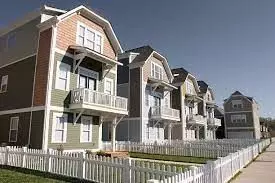
Down Payment Assistance Programs: Your Key to Ownership
Down Payment Assistance Programs: Your Key to Ownership Homeownership remains a quintessential part of the American Dream. However, with escalating property prices, saving for a down payment can be a significant hurdle. This is where down payment assistance programs come into play, acting as a crucial lifeline for aspiring homeowners. In this article, we'll delve into the different types of down payment assistance programs, their benefits, and how you can take advantage of them. Understanding Down Payment Assistance Programs Down payment assistance programs are initiatives designed to help potential homeowners cover the initial costs of purchasing a home. These programs can take various forms, including grants, loans, and tax credits, each aimed at easing the financial burden of a down payment and closing costs. Types of Down Payment Assistance Programs 1. Government-Funded Programs Federal Programs: These include initiatives like the Federal Housing Administration (FHA) loans and the Department of Housing and Urban Development (HUD) grants. These programs offer substantial aid and are backed by robust resources. State Programs: Many states have their own specific initiatives tailored to local needs, offering a diverse array of options for prospective homeowners. 2. Non-Profit Organization Initiatives Non-profit organizations often focus on community-specific needs, providing tailored assistance that addresses local housing market challenges. These programs may offer grants or zero-interest loans, combined with educational resources to guide homebuyers. 3. Employer-Sponsored Assistance Companies recognizing the value of supporting their employees' homeownership goals have started to offer financial aid for down payments. This not only helps employees achieve personal milestones but also enhances job satisfaction and loyalty. Navigating Eligibility and Application Processes Securing down payment assistance typically requires meeting certain eligibility criteria. Common qualifications include income limits, which ensure that aid goes to those who need it most, and credit score requirements, which help lenders assess risk. Additionally, many programs mandate the completion of homebuyer education courses to prepare applicants for the responsibilities of homeownership. The application process, while potentially complex, is a critical step towards obtaining assistance. Applicants must gather necessary documentation, such as proof of income, credit reports, and personal identification. Following this, they must complete and submit application forms, often accompanied by a detailed explanation of their financial situation and housing goals. Financial Implications and Benefits The financial benefits of down payment assistance are manifold. Primarily, these programs reduce the initial out-of-pocket costs for homebuyers, making the dream of owning a home more achievable. By lowering the down payment requirement, these programs can also lead to more favorable mortgage terms, including lower interest rates and monthly payments. In the long term, homeownership can significantly enhance financial stability and wealth accumulation. Owning a home builds equity over time, offering a valuable asset that can appreciate in value. Additionally, fixed mortgage payments provide predictability in housing costs, as opposed to fluctuating rent prices. Real-Life Impact and Future Prospects The impact of down payment assistance programs can be seen in numerous success stories. For instance, a young couple in Texas was able to purchase their first home through a state-sponsored grant, which covered their entire down payment. Such stories highlight the transformative power of these programs, turning seemingly insurmountable barriers into achievable milestones. Looking ahead, the landscape of down payment assistance is poised to evolve. Increased funding for existing programs and the introduction of new initiatives are likely, driven by the ongoing need to make housing affordable. Future trends may include more employer participation and innovative funding mechanisms, further broadening access to homeownership. Addressing Common Misconceptions Despite the significant benefits of down payment assistance programs, several misconceptions persist that may deter potential beneficiaries. One prevalent myth is that these programs are solely for low-income individuals. In reality, many middle-income families also qualify, as eligibility criteria often consider local housing market conditions and cost of living variations. Another common misconception is that assistance programs are exclusively for first-time homebuyers. While it is true that many programs prioritize first-time buyers, there are numerous initiatives available to repeat buyers as well. These programs recognize that even experienced homeowners may need support in different circumstances. Maximizing the Benefits of Down Payment Assistance To make the most of down payment assistance, prospective homeowners should thoroughly research available programs and understand their specific requirements. It's advantageous to explore multiple programs simultaneously, as this can increase the likelihood of receiving aid. Many applicants may qualify for more than one type of assistance, such as a state grant combined with a non-profit loan. Moreover, maintaining a good credit score and a stable income can enhance eligibility and improve loan terms. Completing homebuyer education courses not only meets program requirements but also equips buyers with valuable knowledge and skills for managing their new home and finances effectively. The Role of Real Estate Professionals Real estate agents and mortgage brokers can be invaluable allies in navigating down payment assistance programs. These professionals are often well-versed in the various options available and can provide guidance tailored to an individual's unique circumstances. They can help identify suitable properties within budget constraints and negotiate favorable terms with sellers and lenders. Additionally, real estate professionals can assist in assembling the necessary documentation and completing application forms accurately and efficiently. Their expertise can streamline the process, reducing stress and increasing the chances of a successful outcome. Community and Economic Benefits Beyond individual advantages, down payment assistance programs contribute to broader community and economic benefits. By making homeownership more accessible, these programs can help stabilize neighborhoods, as homeowners are more likely to invest in their communities and maintain their properties. Increased homeownership rates also have positive ripple effects on the local economy. Homebuyers often spend money on home improvements, furnishings, and other related goods and services, which supports local businesses and creates jobs. Moreover, stable housing markets contribute to overall economic stability and growth. Future Trends and Innovations The future of down payment assistance programs is likely to be marked by innovation and expansion. As housing affordability continues to be a pressing issue, policymakers and housing advocates are exploring new ways to enhance and diversify assistance options. Emerging trends may include increased employer participation, with more companies offering housing benefits as part of their employee wellness programs. Technological advancements are also playing a role, with online platforms and tools making it easier for homebuyers to find and apply for assistance. These digital solutions can streamline the application process, provide educational resources, and connect applicants with appropriate programs more efficiently. Conclusion Down payment assistance programs are a pivotal resource for aspiring homeowners, offering a viable path to achieving the dream of owning a home. By reducing the financial hurdles associated with down payments, these programs open doors for individuals and families who might otherwise be excluded from the housing market. As the landscape of housing assistance evolves, staying informed about available options and understanding how to navigate the application process will be crucial. With the right support and resources, homeownership can become a reality for many more people, fostering stronger communities and contributing to economic prosperity. The key to unlocking these opportunities lies in the robust and diverse array of down payment assistance programs designed to make homeownership accessible to all. Check out our Free Home Buyers Guide

Top 8 Reasons Why Your House Might Not Sell in the Charlotte
Introduction:Selling a house in the Charlotte, NC area can be an exciting but challenging endeavor. While the market in this region is generally favorable, it's important to be aware of the potential obstacles that could hinder the sale of your home. In this blog post, we will explore the top eight reasons why a house might not sell in the Charlotte, NC area and provide insights into how to overcome these challenges. 1. Pricing:One of the most common reasons a house doesn't sell is an unrealistic pricing strategy. Setting the right price is crucial to attract potential buyers. Overpricing can deter interested parties, while underpricing may raise suspicions about the property's condition or value. Work with a knowledgeable real estate agent to determine a competitive and fair price that reflects the market conditions and your home's features. 2. Presentation and Staging:First impressions matter, and the presentation of your home can significantly impact its marketability. If your house lacks proper staging, cleanliness, or curb appeal, potential buyers may quickly lose interest. Invest time and effort in decluttering, deep cleaning, and enhancing the curb appeal. Consider professional staging services to showcase your home's potential and create an inviting atmosphere for buyers. 3. Inadequate Marketing:Effective marketing is essential to attract potential buyers to your home. If your house is not getting enough exposure through online listings, social media, or traditional advertising channels, it may struggle to generate interest. Make sure your listing stands out by using high-quality photos, engaging property descriptions, and comprehensive information. Leverage the power of online platforms and connect with local real estate agents to expand your reach. 4. Limited Accessibility:Limited or restrictive showing schedules can hinder the sale of your home. Buyers often have tight schedules and may be unable to view your property if they can't get convenient access. Consider allowing flexible showing times or using technologies like lockboxes or electronic access systems to facilitate showings without compromising security. 5. Property Condition and Repairs:A house that requires substantial repairs or updates may deter potential buyers, as they may worry about the time and costs involved. Make sure your home is in good condition by addressing any necessary repairs, such as leaky faucets, cracked tiles, or damaged fixtures. Consider making strategic upgrades that add value and appeal to potential buyers. 6. Lack of Visual Appeal:Buyers are drawn to homes that feel warm, inviting, and visually appealing. If your house lacks proper lighting, has outdated or overly personalized décor, or lacks a cohesive style, it may struggle to attract attention. Enhance the visual appeal by maximizing natural light, repainting in neutral colors, and updating fixtures as needed. Hiring an interior designer or home stager can help you present your home in its best light. 7. Location:While location is something you can't change about your home, it is a critical factor for buyers. Houses in less desirable locations, such as busy roads, noisy areas, or areas with limited amenities, may take longer to sell. Highlight any positive aspects of the location, such as proximity to schools, parks, shopping centers, or major transportation routes. 8. Limited Buyer Appeal:If your property lacks features that appeal to the majority of buyers in the market, it may face difficulties in selling. Consider the needs and preferences of potential buyers in the Charlotte, NC area and make improvements accordingly. This could include upgrades such as energy-efficient appliances, modern flooring, or outdoor amenities like a deck or patio. Conclusion:While the Charlotte, NC area offers a favorable real estate market, there are various reasons why a house may not sell as quickly as expected. By understanding and addressing these challenges, such as pricing strategy, presentation, marketing, accessibility, property condition, visual appeal, location, and buyer appeal, you can increase your chances of a successful sale. Collaboration with a trusted real estate professional and taking proactive steps to enhance your home's marketability will position you for a successful transaction. Good luck!

Exploring Charlotte North Carolina
Charlotte, North Carolina is a vibrant city that offers a lot of attractions, culture, and history for visitors and residents alike. Whether you are looking for art, sports, nature, or nightlife, you will find something to suit your taste in the Queen City. Here are some of the highlights of Charlotte that you can explore and enjoy. Art and Museums Charlotte has a rich and diverse art scene, with many museums, galleries, and public art installations to admire. Some of the most popular museums include: The Mint Museum1: This museum has two locations, one in Uptown and one in Randolph, that showcase collections of American, European, African, and Asian art, as well as contemporary art and design. The Bechtler Museum of Modern Art2: This museum features works by some of the most influential artists of the 20th century, such as Picasso, Miro, Warhol, and Calder. The museum also has a stunning architecture and a sculpture garden. The Harvey B. Gantt Center for African-American Arts + Culture3: This museum celebrates the contributions and achievements of African-Americans in various fields, such as music, literature, dance, and visual arts. The museum also hosts exhibitions, performances, and educational programs. Sports and Entertainment Charlotte is a sports lover’s paradise, with three professional teams and several venues to catch a game or a concert. Some of the most popular sports and entertainment options include: The Carolina Panthers4: The NFL team that plays at the Bank of America Stadium in Uptown. The Panthers have a loyal fan base and a fierce rivalry with the Atlanta Falcons. The Charlotte Hornets5: The NBA team that plays at the Spectrum Center in Uptown. The Hornets have a history of producing star players, such as Larry Johnson, Alonzo Mourning, and Kemba Walker. Charlotte FC6: The MLS team that will debut in 2022 at the Bank of America Stadium. The team is the newest addition to the city’s sports scene and promises to bring excitement and diversity to the soccer fans. The NASCAR Hall of Fame7: This museum honors the legends and history of NASCAR, the most popular motorsport in the US. The museum features interactive exhibits, simulators, artifacts, and a 278-seat theater. Nature and Outdoors Charlotte is surrounded by beautiful nature and offers many opportunities for outdoor recreation and adventure. Some of the most popular nature and outdoor activities include: The U.S. National Whitewater Center8: This facility is the world’s largest man-made whitewater river and offers rafting, kayaking, zip-lining, rock climbing, biking, and hiking trails. The center also hosts festivals, concerts, and races throughout the year. Freedom Park: This park is a favorite spot for locals and visitors alike, with a 7-acre lake, playgrounds, tennis courts, volleyball courts, and walking paths. The park also hosts the annual Festival in the Park, a three-day event that features arts, crafts, music, and food. The Daniel Stowe Botanical Garden: This garden is a 380-acre oasis of flowers, plants, fountains, and sculptures. The garden also has a conservatory, a visitor pavilion, and a children’s garden. Nightlife and Dining Charlotte has a lively and diverse nightlife and dining scene, with many options to suit any mood and budget. Some of the most popular nightlife and dining areas include: Uptown: This is the heart of the city, where you can find skyscrapers, museums, theaters, and sports venues. Uptown also has a variety of bars, clubs, restaurants, and hotels to choose from. South End: This is the trendy and hip area of the city, where you can find art galleries, breweries, boutiques, and cafes. South End also has a light rail system that connects it to Uptown and other parts of the city. NoDa: This is the arts and entertainment district of the city, where you can find live music, comedy, theater, and street art. NoDa also has a vibrant and eclectic mix of bars, restaurants, and shops. Charlotte, North Carolina is a city that has something for everyone, whether you are looking for culture, adventure, or fun. If you are planning to visit or move to Charlotte, you will not be disappointed by the charm and energy of this city. I hope you enjoyed this blog post and learned something new about Charlotte. Thank you for reading! 😊
Categories
- All Blogs (56)
- Buying a Home in Charlotte, NC (2)
- Charlotte Residential Real Estate News (3)
- Finding A Home (4)
- Lifestyle and Community (1)
- Living In Charlotte NC (24)
- Mortgage Loans (7)
- Neighborhood Guides (3)
- Real Estate Market Trends (2)
- Relocation and Moving to Charlotte (1)
- Things to do in Charlotte NC (3)
- Veterans (3)
Recent Posts










